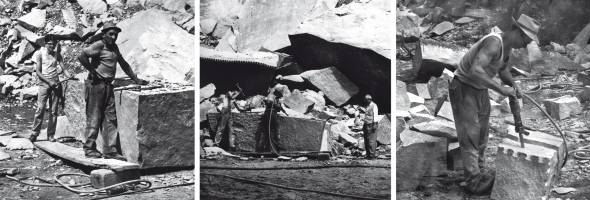History
ONE FAMILY, ONE GROUP, TWO BRANDS AND ONE HISTORY IN STONE CUTTING
(Interview to Emilio BROCCO)
When did you start working in the quarry?
I started working in 1966 when I was 14 years old. My father at the time had two granite quarries and the processing was hand made. In the quarry there were working 120 persons and the annual productivity was more or less of 3.000 m3 of material (diorite). To dig the material the explosive was used. The explosion of the wall detached the material from the mountain and then the blocks suitable to the production of slabs were selected. Only the 3-4% of the material produced by the explosion were blocks that could be sent to the sawmill, the remaining was sold as blocks, borders and stone masonry.
How were the slabs obtained at the time?
Only the selected blocks were sent to the sawmill, were they were cut using multi-blade gangsaws. The gangsaws with alternate oscillation were made of steel blades that with the alternate motion and the silica sand were abrading the stone. The processing time were very long: to cut a block in slabs it would take a month of work. Also the blades and the components of the gangsaw got worn quickly and so the production costs were very high: the diorite was sold at about 70.000 £/m2. Nowdays the value of the square meter is about 30 €.
When did you understand that it was time to change gear and industrialize the company?
In the mid 70's we started to feel the need to innovate and renew the quarry labour. I immediately tried to convert the company, because all was based on manual labour so we felt the need to automate the processing and extraction cycles. The first big change came when we started using the diamond wire in the quarry. The work in the quarry with the plastified diamond wire raised the productivity of the blocks to 15-20%, reducing the quarry spread up to 20%. The material that could not be sold as blocks is used for the production of stones for embankments, masonry stones, kerbstones, and products of small sizes. The first wires were realized with springs. Those wires had a very poor performance, and when they broke, the risk that a spring was launched as a bullet, risking to hit someone was rather high. So I thought to plastify the diamond wire and raise this way its duration and its safety.
Regarding the materials processed was there an evolutive process?
Yes, in the last years it has been possible to cut materials that until recently it was impossible to use the diamond wire to cut them. The market has brought more and more difficult materials and we had the ability and the strength to take new challenges. In the last years we managed to diversify the production, to follow the requirements of the market and of the clients, creating wires able to cut highly abrasive materials such as bronzite, pegmatites and stones with high quartz content.
What's the current market situation?
The company's know-how has continuously increased as the time was passing and we developed more and more performant technologies and solutions. We tried to improve reliability of the machines, raise the processing speed and improve the performance of the wire. Currently the multiwire compact saws with 40 and 65 wires allow to cut in one descent a full block and to process up to 3-4 blocks a day.
Which are the future objectives of the company and of the group?
An increase of the productivity and a parallel reduction of the costs are undoubtedly some of the most important goals. A continuous research lets us day after day develop cutting solutions with reduced environmental impact. The possibility to obtain a wire with smaller diameter has a strong environmental impact because it reduces the quantity of raw materials needed for the construction of the wires and at the same time reduces the quantity of stone waste during the cut. At the same time the designing of the machines that reduce vibrations allowing to significantly reduce the noise pollution during the processing.






